Last fall, members of the Deerfield Chapter of Trout Unlimited began a study of the Deerfield River because they were pretty sure that it had a sustaining population of wild brown trout. They wanted to find out for sure because the Federal Energy Regulatory Commission (FERC) is in the process of re-licensing the Bear Swamp hydro-electric facilities which includes the Bear Swamp pump storage. The river system starts above Somerset Reservoir, then Harriman and then Sherman reservoirs to Bear Swamp and then to Fife Brook dam.
Water is pumped up to Bear Swamp Pond and then it is released to the turbines to generate electricity. That doesn’t impact water flows below Fife Brook Dam, but what does impact flows is amount of water which is coming from up above and then what is done with this water in the pump storage facility. How much can they manipulate the water to minimize the impact that is going on with the 17 miles down below? That’s what the FERC relicensing is addressing.
The Deerfield River Watershed is complicated, encompassing 73 miles of water with 10 dams. There are two different license holders involved, Great River who owns the operations above Fife Dam, and Brookfield who owns operations below Fife Brook Dam. The Deerfield River Chapter of TU is dealing primarily with Brookfield for FERC Relicensing. Brookfield receives its water from up above (Great River). The FERC relicensing study area is the 17 miles downstream from Fife Brook Dam down to Dam #4 in Buckland.
Every day there is a hydro event. The mandated minimum flow is 125cfs (cubic feet per second) and on a daily basis it pumps up to 800, 900 or 1000 cfs. During the winter months they run a lot of water (hydropeaking) which is considered bad for the environment and has a significant effect on fish. (There is no disagreement about that unless you are into white water sports).
Initially, the Deerfield River TU Chapter requested a trout spawning study. FERC denied it twice on the basis that there was no proof of adverse effect on the ecology on fish below the Fife dam. Brookfield maintained that this is a put-and-take fishery and that is what MassWildlife values. Fish are put it, taken out or are caught and released. They said that it is a vibrant trout area, so, what’s the problem?
Brookfield was also questioning why they should pay for this study when nothing that they were doing was harming the fish. It is not what Brookfield is doing at Fife Brook dam, they say, it’s what is happening up above that is having the significant impact. Blame it on Great River whose license comes up in 20 years for renewal. Consequently, the study became stalled.
Deerfield TU couldn’t answer the question of what the problem was and how it was impacting the fish. MassWildlife did not believe there was significant spawning in the Deerfield River and believed that any kind of spawning took place in the tributaries and not the mainstem. Well, the TU study proved otherwise.
A Deerfield TU board member read about what was going on at the Henry’s Fork River in Idaho dealing with the significant problems there because of winter flows. Brown trout spawn there in the fall, too. So, he brought information to his TU chapter and asked what they thought about that spawning study. They decided that they were going to go ahead with a similar study and pay for the $2,000 cost themselves.
They raised money on their own, approached the Mass/RI Council of TU as well as other TU chapters for financial assistance. (I’m proud that our local Taconic Chapter kicked in some money). Thomas & Thomas Fly Rod Company contributed $2,000. They hired Dr. Michael Cole, an aquatic scientist to lead the effort.
They didn’t know how much spawning was going on, but if they could prove what the power companies were doing was detrimental to spawning trout and quantify it, it would be a game changer. They had to partner up with USFWS, MassWildlife and the Connecticut Water Conservancy recognizing that they weren’t going to be able to deal with it alone.
About a dozen chapter members went out in late October looking for redds. (spawning nests made by trout). In one particular area, there were 40 redds! Each time they identified a redd, they measured its length, depth, sub-straight, the size of the rocks, GPS settings and marked it with a red flag. Once they found the egg locations, they went back and took samples in low waters. Due to water fluctuations, some of the redds were out of water.
They found 12 of the redds and 8 of them contained eggs. That indicated that there was a significant amount of spawning activity that was going on in shallow water. What the fish appeared to be doing was moving into these areas during high water to do their spawning and when the waters came down they abandoned them. They choose these spots, not because of sub-straight as believed, but also due to some upwelling of the water (40 redds were in one area). Many of the tail spills were completely out of water.
In the 7 ½ mile stretch of the river, volunteers found 101 redds, with 35 of them having eggs. (they only covered about 60-70% of the water so there could be other areas with redds). They took 35 samples of eggs and had DNA tests done, thanks to financing from Thomas & Thomas. All of them were brown trout eggs except for two which were rainbows.
Volunteers went out on a cold March day and found that some of those flags had moved and redds were lost. In one redd they found 80 eggs and 70% of them were alive, and they found eggs in various stages. They are now going to FERC with scientific evidence, and they need to know how much velocity is needed to cover these redds.
The Chapter proved what they wanted to prove and now agencies such as MassWildlife, USFWS, UMASS and others will take it from there. USFWS was “blown away” with the results. MassWildlife, which was originally of the opinion that this spawning was not going on, has gone back to FERC and there will be more extensive sampling by them.
They will be looking for more water releases during the winter months. In the summer months they have to have a certain amount of water to make mandated releases (for the rafters), but during the winter they have no need for them – but the trout do.
The Deerfield TU chapter definitely showed that hydropeaking has an adverse impact on trout. Their goal was to get the State and Federal resources to further study the Deerfield and its tributaries. They want to enhance the wild trout population, work with the state agencies for better management practices, and improve the wild trout population. They would like to see the Deerfield River develop its own surviving strains for stocking, rather than imports, and answer the question. “Can a substantial wild trout population exist exclusively in the upper stretches of the Deerfield River? Right now, they don’t know.
There will be updated information on this subject in next week’s column.
Category Archives: Fishing
MassWildlife increases antlerless deer permit allocations in Western District
Some 725 more antlerless deer permits are being issued in the Western District (Wildlife Management Zones 1 through 4) this year. The largest increase will be in Zone 3 where 300 more permits will be issued bringing the total to 1,400. That is followed by 125 increases in Zones 4N and 4S, bringing those totals to 500 and 400 respectively. Permits in Zone 1 will go up by 100 to 500, and lastly an increase of 75 in Zone 2 brings that total to 250. MassWildlife classifies our Western District deer herd as stable, a place where they want to be.
So, did you get a permit? Effective last Wednesday, you can find out by clicking onto the MassFishHunt website and following the instructions. If you did receive one and you plan to shoot an antlerless deer, you owe MassWildlife $5.
The attached chart lists the statewide antlerless deer permit information by Wildlife Management Zones.
As you can see, the eastern part of the Commonwealth has some serious issues with getting the deer population down to desired numbers. For example, in Zone 10 MassWildlife would issue 12,000 permits, but not enough people applied for them. Thus, they have a 9,100 surplus. A similar situation exists in Zone 11. Not good. One could only imagine the problems with deer/auto accidents, deer ticks and difficulty in sustaining the new growth in the forests out there. Not to mention the shrubs in residential areas that are destroyed each winter.
Surplus antlerless deer permits for Zones 9 through 14 will be available for sale and will be staggered over the following days in September:
• Zone 11: Tuesday, September 25 at 8 a.m.
• Zone 10: Wednesday, September 26 at 8 a.m.
• Zones 9, 13, and 14: Thursday, September 27 at 8 a.m.
•
Surplus Permits must be purchased within 15 minutes after being placed in your shopping cart. You may purchase only one Zone 11, one Zone 10 and one Zone 9 permit per day; up to four permits per day may be purchased for Zones 13 and 14. The permits cost $5 each.
Incidentally, the Department of Conservation and Recreation recently opened 7,500 acres of land to hunting in the Wachusett Reservoir Watershed. That is north of Worcester. Hunters can apply for a 5-year permit for property west and east of Rte. 190, (open for all game during all hunting seasons), or an annual permit for property immediately adjacent to the Reservoir, designated as the Reservoir Zone,(for deer only December. 1 through 31). Permits will be selected by lottery. If interested, apply by August 31. Both permit types are free. Click onto https://www.mass.gov/service-details/wachusett-reservoir-watershed-deer-hunt, for details.
Welcome back firefighters
According to MassWildlife, three members of their prescribed fire crew, Fletcher Clark, Chris Connors, and Ben Mazzei, assisted in securing wildfires in Québec Province, Canada for two weeks this past July. They were joined by 16 wildland firefighters from the Massachusetts Department of Conservation and Recreation (DCR) to form the Massachusetts Interagency Wildfire Crew- MA#1 and were mobilized through DCR and the Northeast Forest Fire Compact.
The wildfire hand crew spent time containing two different wildfires, one near Radisson and the other near Lebel-sur-Quévillon in Québec Province. The crew spent most of its time on a large 24,500-acre fire on Wilson Lake in a remote region of Québec Province. Lightning strikes caused the dry, dense vegetation in the area to ignite and caused the wildfires.
The Massachusetts crew was deployed to these wildfires for two weeks. They worked with other crews to establish helicopter landing sites, coordinate water drops, and secure sections of the fire to keep it from spreading. Securing a section of fire can mean a lot of different kinds of work, says MassWildlife.
The crews set up water pump sites and ran hoses around the section of fire to make sure water was readily accessible to combat the fires. The crew established a fire line around their section. A fire line is essentially a wide path on the ground that is cleared of vegetation, debris, and anything else that can potentially burn to stop the fire from spreading. The crews also went into already-burned areas and put out any hot spots that might have still been smoldering or burning. The crew was helicoptered daily from their base camp to the remote wildfires to perform these duties.
On July 22, the Massachusetts crew returned back to the Commonwealth safely. There are still many wildfires burning in the province of Québec alone. During the past week, rain has somewhat helped with battling the fires. However, if conditions dry out, the potential for large fires to become active again exists. Québec continues to seek assistance from Canadian provinces and the northeastern United States to help cope with these wildfires.
“Please join us in welcoming these dedicated individuals back from this rugged assignment,” said Caren Caljouw, MassWildlife’s Prescribed Fire Program Manager. “We are very proud of the assistance they provided to our Canadian neighbors and know the vast experience they gained will translate directly to improving MassWildlife’s prescribed fire program and working as a cohesive team with DCR and other fire management partners.”
Massachusetts, along with the other New England states and New York initiated the Northeastern Forest Fire Protection Compact—also called the Northeast Compact—in 1947. The Compact was established to provide a means for member states to cope with wildland fires that may become too intense for a single member state to control. In 1970, the provinces of Quebec and New Brunswick joined, making the Northeast Compact international. Currently, the Northeast Compact members include seven states—Maine, New Hampshire, Vermont, Massachusetts, Rhode Island, Connecticut, and New York—and five provinces—Québec, New Brunswick, Nova Scotia, Newfoundland-Labrador, and Prince Edward Island. The Northeast Compact also includes the Fire Department of New York City, the US Forest Service, the US Fish and Wildlife Service, and the US National Park Service.
Adams Outdoor for Youth fishing derby
The AOFY held its annual fishing derby on Reynolds Pond in Cheshire last month. Some 54 kids attended and the winners were as follows: Age 0 to 6 years old: Smallest fish 8 ½ inches – Corbin Porio/ Largest fish 14 1/4″- Layla Jayko. Age 7 to 11: Smallest fish 8″ Charlie Bean / Largest fish 14 1/2″ Wyatt Bellows. Age 12 to 15: Largest and Smallest fish 14 1/4″ and 8 3/4″respectively – Cameron Bostwick. All brook trout came from Berkshire Hatchery. 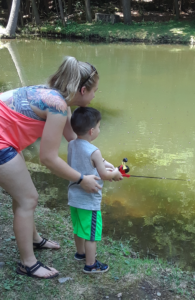
Spokesman Mike Lefebvre thanked all the volunteers from all clubs for another successful year supporting the Youth Fishing Derby.
Fly fishing the Penobscot River in Maine
Recently, a couple of fishing buddies and I traveled to East Millinocket, ME to do some fly fishing in the West Branch of the Penobscot River. This is a large wild river in upper Maine that is noted for its large wild brook trout and landlocked salmon. In addition to myself, there were Ron Wojcik of Windsor, Paul Knauth of Hinsdale and Attorney Michael Shepard of Dalton, MA. It is an 8-hour drive from the Berkshires, so we stopped at Cabelas in Scarborough, ME approximately half way, to rest and pick up a few fishing supplies.
We rented a cabin on Twin Pines NE Outdoor Center on Millinocket Lake in East Millinocket. Each day we drove approximately one-half hour along the Golden Road, the primary road access to the river, to get to an area below Ripogenus Falls where we knew some nice fish were awaiting us.
Ripogenus Falls once controlled discharge from Ripogenus Lake until Ripogenus Dam, (92 feet high and 704 feet wide) was completed at the upstream end of the Ripogenus Gorge in 1916. The dam forms a hydroelectric reservoir raising the level of Ripogenus Lake to include the upstream Chesuncook Lake, Caribou Lake, and Moose Pond. Hydroelectricity is generated by diverting water 2,400 cu ft/s through a mile-long penstock around the former falls.
The West Branch once had river log drives transporting pulpwood to a lumber mill in Millinocket. They began in 1917 and the last one was in 1928. Environmental concerns ended river transport of pulpwood in 1971 when the Great Northern Paper Co. opened the above mentioned Golden Road. Since then the lumber industry has been greatly diminished and the Millinocket mill is being torn down.
We left home around 5am and arrived at our cabin around 2pm, ate a sandwich and, although a little tired, we were off to the river by 4pm or so. We were concerned about the forecast of rain for the next 2 days, so at least we could get some decent weather to fish on the day of arrival. Once at the river, we realized that in our tired condition and haste, Paul left his rod at the cabin, Ron left his reel there and I forgot my flip down spectacles. Nice start, hey? No problem, we usually take two rods and reels so a little bit of lending and everyone went to the stream fully equipped, except for my spectacles.
They were releasing 2,400 cfs of water which made the river level just about perfect for fishermen as well as the commercial rafters and kayakers.
The fishing was outstanding with many brookies and landlocks caught and released. We left the river earlier because even though we brought food to cook up in the cabin, we were too tired to cook and decided to eat at a restaurant in the complex where we were staying. The only problem was that it closes at 9pm and we had a half hour ride to get back. We did make it in time.
The weather forecast of rain for the next day was wrong and we had a pleasant and fruitful day, catching lots of cooperative fish. But this time we stopped fishing around 3pm, drove back to that restaurant and ate when it opened at 4pm. Then back to the river and we fished until total darkness, sometime after 9pm. That was when Ron landed the largest brook trout of the trip, one estimated to be around 18 inches. He caught it on a gray caddisfly in some pretty heavy current.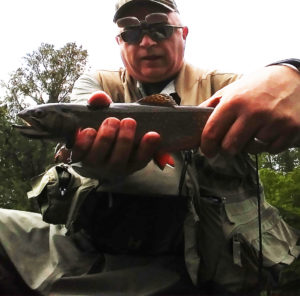
The next morning, the rain continued to hold off and it was another beautiful day. That was when Mike connected with the largest fish of the trip, a landlock salmon estimated to be 20 inches. He caught it on a Stimulator (a fly which imitates an adult stonefly).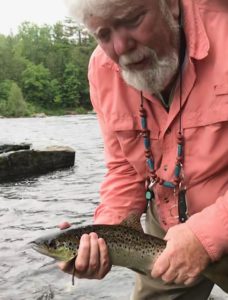
Once again, we knocked off around 2pm, went back to the cabin and this time had an early dinner of spaghetti and chicken/sausage prepared by Mike. After gorging ourselves, three of us went out fishing again. (Paul’s back was giving him some trouble so he stayed at the cabin, cleaning it up so that we could get an early start for home the following morning).
The fishing was slower that evening, although Ron caught several nice landlocks and brookies. Just as we left the river in darkness, it started to rain and rained all night.
It was a beautiful trip shared by good friends. We all caught and released lots of nice fish. Of course, the biggest fish didn’t wait to be released, but decided to release themselves, usually taking our flies with them. Those are smart and scrappy fish up there. Once hooked, the landlocks frequently jump 3 feet out of the water and they no sooner come down and they are airborne again. They are masters at tangling around submerged rocks and cutting your leaders. If you use a heavy leader, the fish won’t touch your fly, and if you use a thinner leader, they will take your fly, but usually break you off. It’s a Catch 22 situation, but very enjoyable.
It is a tough river to wade. Three of the four of us took spills; I went down twice but Mike had the most spectacular. Ron nearly injured his shoulder with his fall, but none of us got seriously banged up.
One day, we came across Tom Fuller and his wife Pat on the stream. Tom is a fellow member of the New England Outdoor Writer’s Association who wrote several excellent fly fishing books including: Getting Started in Fly Fishing, The Complete Guide to Eastern Hatches, Trout Streams of Southern New England and Underwater flies for trout. We had a nice chat on the riverbank.
At night, we sat around the cabin table having a drink and munching on baked goodies that our spouses baked and sent along with us. Our conversations covered everything from the day’s fishing, to troubles with kids today, to the Donald, etc.
The most successful flies were adult and emerging caddisflies, size #16, such as Henryville Specials, Elk Hair Caddis, other caddisfly emergers, Blue Winged Olive mayflies and the Stimulator stone fly. Paul tied up and shared an emerger fly of which the fish couldn’t get enough. I’ll bet he could have charged $20 apiece for it.
But a fishing trip to Maine isn’t all about catching fish. We enjoyed the company of two bald eagles that perched on trees directly across the river from us. At one time, a gull swam by with a fish in its bill. That prompted the eagles to try to take it away, swooping at the gull until it dropped the fish. For the next several minutes, both eagles and the gull flew around us looking for that fish in the waters but they weren’t successful.
While on the Golden Road, we frequently observed a mother moose with her young. In the early mornings, we would hear and observe loons paddling along on the quiet lake where we were staying, as we enjoyed views of Mount Katahdin.
Aah, fly fishing with good friends on the Penobscot……it doesn’t get much better.
Lenox Sportsmen’s Club Pistol Team claimed State title
Last month, the Lenox SC Pistol Team went on a shooting rampage and took 1st place in the Berkshire County pistol competitions which they have won for the last few years, and then competed in the State Finals and won that, too. According to Team Captain David Cimini, that could be the first State title ever for the club and perhaps for a Berkshire team, at least in recent memory.
They scored 4,126 out of 4,500 possible points, beating the 2nd place Merrimac Valley Pistol League by 21 points.
To get to the State finals, the 11 to 15- member pistol team had to win the Berkshire County title. Once that was accomplished, they qualified to represent Berkshire County at the State level.. They had to trim their number of shooters down to 6, selecting their top scorers. Eight teams competed at the State level, representing the different counties.
The rules state that teams must shoot .22 caliber pistols, using open or red dot sights, one handed, at a bull’s eye target at a 50- foot range. The scores entered can only be from the accumulation of the five top scorers. It is called a 900 match. Each shooter has 90 shots at 10 points apiece with a maximum score of 900 points.
The Lenox team shooters were: Team Captain – David Cimini, Co-Captain Ray Scheufler, Peter Kirchner, Tom Greenleaf, Gregg Proctor and James Denault. All are Pittsfield residents except for Proctor who resides in Hinsdale. The top shooter was Denault who scored 834 out of 900 possible points.
According to Cimini, there are some very good shooters at the eastern end of the state, many of them are in weekly leagues, similar to bowling leagues. The Lenox Club only shoots 10 or 12. One of those eastern teams usually takes the State title every year. “This year was our year”, he said, “We worked hard., we practiced hard and we really put a lot into it. And it paid off.” Over the years, they have placed anywhere from 2nd to 8th. Last year, Lenox finished 3rd.
I was hoping to get a picture of these sharpshooters holding the trophy and medals, but the awards are late and have not arrived yet. When they do arrive, I hope to include a picture in a future column.
Congratulations, gents! Mighty fine shooting, mighty fine!
Recent Massachusetts DFW activities now that trout stocking is over
Recently, they completed stocking Quabbin Reservoir with its annual allotment of 10,000 landlocked salmon raised at the Palmer Fish Hatchery. It will take about 3 years for these fish to reach the 15″ minimum size for harvest.
According to Western District supervisor Andrew Madden, they successfully banded bald eagle chicks at Richmond Pond and the Westfield River in Russell.
They are also continuing deployment of black bear GPS radio collars. They added 1 collared female this past spring.
Teachers are tutored on fly fishing
Ronald Wojcik, of Windsor, MA is a teacher at Taconic High School in Pittsfield, coaches the Hoosic Valley Girls’ Basketball Team and also is a superb fly fisherman. So, it makes perfect sense for him to start an after-school fly fishing club for the Taconic High students. About 12 years ago, he did just that and since then about 50 students have taken the course.
The course includes lessons in fly fishing and casting, fly tying (depending on interest), fly fishing equipment, entomology, species of trout, videos, etc. His availability to teach these subjects depends on his basketball coaching schedule for the Hoosic Valley Girls’ Basketball Team.
This past year, Ron had no students available to take his fly fishing course, in spite of sending e-mails and posting fliers about the course. The students were tied up in other sports or had after school jobs. When the teachers saw the flyers, they asked, “What about us? We would like to learn to fly fish, too.” Ron agreed and as a result, 4 Taconic teachers, and the Wahconah High School Girls’ Basketball Coach, Liz Kay, attended the fly fishing lesson. (Ironically, Liz’s team defeated Hoosic Valley in the play-offs last year, but Ron welcomed her anyway). The Taconic teachers were Kris Pearson, Patrice Lattrell and Ana Larkin. Amy Green is a health technician volunteer.
On the evening of June 19, Ron invited the teachers up to his house to learn to fly fish for trout in his private pond, a body of water of about ¾ acre. Also invited were 5 members of the Taconic Chapter of Trout Unlimited to do the one-on-one tutoring. They were Stephen Smith, William Travis, Marc Hoechstetter, Paul Knauth and me. After dining on pizza, we got down to the business of casting for and catching trout.
The teachers were a mix of novice anglers and those with some experience. The teacher that I was mentoring, Kris Pearson, had never fly fished before, and on her second cast, a large trout hammered her black wooly bugger fly and went deep to the bottom and put up a fierce fight.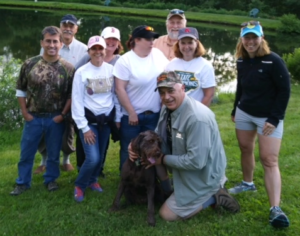
You should see the excitement that ensued with Ron rushing over joining me with instructions. I think Kris was a little intimidated and tried to hand the rod over to me. But it was it was her fish to catch or lose. It was a brute, probably one of Ron’s rainbow trout that he stocked in the 6 to 10- inch range 4 or 5 years ago and now weighed around 5 lbs. After swimming around the pond, it finally got off. Liz immediately became sold on fly fishing and now wants to buy a starter fly fishing outfit.
About halfway through the fishing lesson, Ron’s wife Diane Wojcik brought down to the pond some freshly made and still warm cookies. Their labra-doodle dog, Hershey, checked on all of the lady fly fishers, too. And then they went back to fishing.
Ron made sure that all of the fish that were caught were resuscitated and swam away to fight another day.
So, did these teachers pass or fail? They passed with flying colors. By the end of the session, all of them were decent fly casters and all either caught trout or had them on. They appeared to be having a great time, as did the mentors.
There was no need to send them home with bad report cards. They can now advance to the next phase, that of catching fish out of our local lakes and rivers and enjoying all of the beautiful sights that our Berkshires have to offer. Also, they can go on summer vacation now!
A classic fishing trip to the Adirondacks
Fishing buddy Paul Knauth of Hinsdale and I recently returned from a 4-day fly fishing trip to New York’s Adirondacks region. Our intent was to fish the AuSable River in Wilmington, NY, a small town near Lake Placid. We were hoping for good weather, good fishing and no mosquitos or blackflies. (We should have also hoped for no “no-see-ums”).
On the way up the Northway, I was wondering if anything would happen on this trip which would warrant mentioning in this column. Hopefully, whatever happens would be positive.
Every time I fish there, thoughts of the late Francis Betters surface. For 47 years, as the owner of the Adirondack Sports Shop and renowned fishing expert, he was at his desk tying up flies and offering advice to customers and fellow fishermen. He once told me that he tied and sold nearly 30,000 flies a year. He is credited for creating several great trout flies, most notably the AuSable Wulff (my favorite fly), the Haystack, the Usual and several others. The AuSable Wulff was named one of the top 10 trout flies of all time by Field and Stream magazine, along with the Haystack. Fran also wrote several fly-fishing and fly-tying books. He was inducted into the Catskill Fly Fishing Hall of Fame in 2008 and passed beyond the riverbend in 2009.
Shortly after arriving and checking into our cabin (Wilderness Inn) Paul and I headed out to fish the river. Paul chose to head upstream and fish down to the car while I chose to go downstream and fish back. The river was on the low side this year so I kept walking downstream until I found good looking water, albeit on the wild and turbulent side.
Thinking of Francis, I chose to fish with one of his Haystacks. In fact, I believe it was one that he tied up for it was much better than the ones I tie. On the 3rd cast, the heavy current swung the fly immediately to the outlet rim of the hole and got snagged onto a rock ….or so I thought. When I tried to work it off of the rock, there was a serious pull that indicated that a big trout was on the other end of the line. After a serious battle, I was able to bring the fish to my feet and discovered that it was a beautiful brown trout of about 18 inches long. 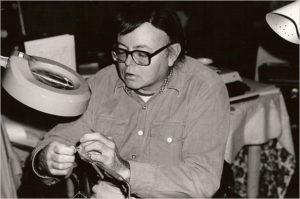
Hoping to get a picture of it, I reached for my smart phone. Of course, it was in my pants pocket, way down deep in the chest waders. While the fish was resting at my feet in about 6 inches of water, I finally got the phone out to take a picture. I decided to lay the reel and rod next to the fish so that one could get a rough idea of the its size. But doing that caused the fish to dart away and snap the leader. It didn’t know it was free and lingered a while, allowing me to take pictures of it. After it swam away, I distinctly remember saying, “Here’s your fly back, Francis”.
Perhaps that’s the story for this column.
The following night, Paul was fishing with a Blue Winged Olive emerger fly when he hooked into a lunker. After a lengthy battle, with the fish swimming all around that pool, he finally landed it. It also was an 18-inch brown trout. Unfortunately, we didn’t have a camera with us, but I can attest to its size. It fought so hard that I thought I would have to step out of the pool so that it wouldn’t swim near and wrap the line around me. An 18-inch wild brown trout doesn’t come by frequently. In fact, I can probably count the number of them caught in my lifetime on one hand.
Perhaps that would be the story for this column.
On this trip, Paul and I decided to explore the North Branch of the Saranac River to see what the fishing was like there. Neither of us had ever fished the stretch near Clayburg, NY. We spent a day and a half there catching mainly small wild brook and brown trout.
On the second day there, we stopped for a lunch break in a fishing access area. While there, a young girl, approximately 13 years old rode by on a bike, and she had a fishing pole. After lunch, Paul and I separated, this time he headed downstream and I went upstream to a bridge. While approaching it, I saw a bike along the side of the road. It was that girl’s bike and she was fishing where I wanted to go.
From the bridge, I could see that she was fishing with an inexpensive spinning rod and a Zebco reel. After saying “hi” to her and finding out which direction she was going to fish (she was going to fish there under the bridge), I went downstream about 120 feet to give her space. What enfolded then was a scene reminiscent of an old Ed Zern caricature.
All of a sudden, I heard a terrific splash and looking toward the sound, saw the girl fighting a large brown trout which once again jumped a foot in the air. Her inexpensive rod was seriously bent, but she fought and subsequently beached that trout like a pro. I shouted congratulations and commended her for the great job of landing it. “What is it, about 15 inches?” I asked. “I don’t know,” she said “It’s the biggest fish I ever caught”. Oh, how I wished I had the camera there.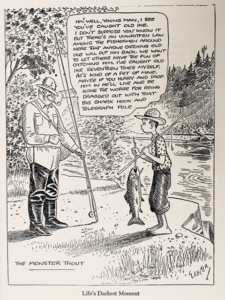
Here I was fishing out in the middle of the river with thousands of dollars worth of equipment consisting of an expensive fly rod, reel, chest waders, wading staff, wooden net, a fishing vest with several hundred trout flies in it and a myriad of other gadgets hanging from it, and catching nothing. And there was this young girl who arrived by bicycle, dressed in shorts and sneakers, fishing from the bank with an inexpensive fishing pole, reel and worms and catching that big fish. How classic is that?
The girl showed up again later that day, this time with her boyfriend who also arrived by bike, a lad of about 14 years old. When Paul saw them, he conceded his fishing spot to them and commented on how she was now famous in the area, having caught that big brown trout (which ultimately measured out to be 14 ½ inches). She was beaming from ear to ear.
After lauding her great accomplishment, I commented to the boy that he was going to have to work hard to catch a bigger trout than her’s. “Well”, he said, “I taught her how to fish!” Paul, picked up on the lad’s wounded pride, immediately said, “You sure did a great job of teaching!
This true story is classic and deserves to be in this week’s column. Wouldn’t you agree?
Questions/comments: Berkwoodsandwaters@roadrunner.com. Phone: (413) 637-1818
There is now an innovative website for citizen science
.
According to MassWildlife, just under 7 million people share roughly 7 million acres of land and water with wildlife in Massachusetts. Roadways crisscross much of the landscape, impacting both people and wildlife. The most obvious impacts are vehicle collisions. Less obvious—but perhaps more influential to wildlife populations—is habitat fragmentation and degradation caused by roads.
MassWildlife and MassDOT have partnered since 2008 to provide safe passages for both wildlife and people, and to address the conservation needs of vulnerable species listed under the Massachusetts Endangered Species Act. This partnership helps incorporate the needs of fish, wildlife, and plants that might have been ignored otherwise during the planning process and maintenance of roadways.
The partnership also has a website where you can report animals you see on the road. If you see roadkill, or a turtle or amphibian crossing the road, consider visiting linkinglandscapes.info to submit information. To submit your findings, click the major project that best fits what you see: reducing turtle roadkill, mapping amphibian crossings, or mapping wildlife roadkill. Fill out the short survey, with detailed location information. There is a Google Map at the bottom of the survey that can be zoomed in and panned to a specific location. The information provided on the website helps MassWildlife and MassDOT determine priority areas to mitigate wildlife-human interactions and how best to manage them.
The agencies suggest that there is another way you can help wildlife on the road and that is to be an alert driver. If you see a turtle crossing a road—and if it’s safe to assist—move the turtle in the direction it’s going. Don’t put it where you think it should go. Slow down if you see a moose or deer on the side of the road or crossing the road. If the animal is crossing the road, don’t swerve around it. Wait patiently for it to cross.
DFW Western District Land Acquisition
MassWildlife recently acquired 150 acres along East Washington Road in Hinsdale. This parcel connects the Hinsdale Flats Wildlife Management Area to the Tracy Pond Wildlife Management Area. It has fields, young forest, old orchards and mature woods, good habitat for most of our wildlife.
All lands acquired by the DFW are open to hunting, fishing, trapping, bird watching, hiking and other forms of passive recreation. The use of motorized vehicles is not permitted.
New Catch & Release State Record Walleye caught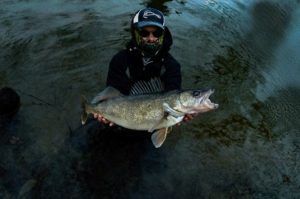
Congratulations to Mike Taylor who recently caught a 29.5″ walleye out of the Connecticut River. Mike is now the catch & release state record holder for walleye.
According to Mass DFW, in the past, they made an extensive yet unsuccessful effort to stock walleye in dozens of waterbodies across the state, but survival rates were low and there was little, if any, natural reproduction. (They even tried stocking them in Stockbridge Bowl in the 1930’s or 1940’s with no reproduction success).
The DFW says that if you’re looking for places to catch walleye in the State, the Connecticut and Chicopee Rivers, as well as the Lakeville system in the southeast, provide good opportunities.
Basic Hunter Education Course
There will be a Basic Hunter Education course held at the Worthington Rod & Gun Club, 458 Dingle Road, Worthingon, MA on July 23, 24, 26 and 27. All four sessions are from 5:30 to 9:00 pm.
You must attend all class dates and times to successfully complete the course. If you are interested in this course and wish to enroll, call (508) 389-7830 immediately; students are enrolled first-come, first-served, and courses fill quickly.
Get those kids outside. Please!
Bass Pro Shops and Cabela’s are certainly doing their share. Recently, they announced that they will be donating some 50,000 rods and reels nationwide this summer in an effort to get kids outside. Recently, Masswildlife accepted a generous donation of 400 rods to its Angler Education Program at the Massachusetts Cabela’s.
They are EPOs, but I still call them game wardens
What this column needs is a good game warden story every now and then. Game wardens (now called Environmental Police Officers in Massachusetts) are very important and are an integral part of our hunting and fishing lore. When I think of the old-time game wardens, I conger up visions of him in his Smokey the Bear Hat, sneaking through the woods and peeking through some pines observing a person fishing right next to a “No Fishing” sign. I am partial to game wardens as my father was once a deputy game warden in the 1920’s and he used to relate some interesting stories to my brothers and me which I hope to pass on in future columns. 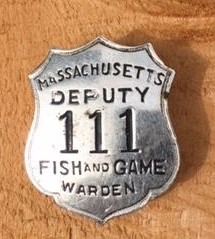
In the meantime, let’s start off with this one from nearby New York. Three hunters charged with illegally killing eight bucks in Columbia County, NY, last December have been fined a total of $16,300, according to New York Police Benevolent Association (PBA), the union that represents the officers who made the arrests.
As reported in the Times Union, Environmental Conservation Officer Jeff Cox received an anonymous tip last Dec. 16 that a poacher had illegally shot a buck after dark on Friday evening. Cox and his partner, Officer James Davey, went to the alleged poacher’s home to investigate and found 19-year-old Hunter Ordway of Chatham preparing several antlered deer for processing and display. During an interview, Ordway admitted he had shot the two larger deer that Friday night and did not tag a third he’d also killed, the PBA said in a statement. Ordway named 41-year-old Jeremy Schemerhorn of Chatham and 24-year-old Ryan Bishop of Niverville as accomplices.
Schemerhorn and Bishop “eventually implicated each other in a variety of illegal hunting activities” in subsequent interviews the PBA said.
The officers seized eight bucks in total: one 10-point trophy, three 8-pointers, one 6-pointer, two 5-pointers and one spike. The meat was donated to the Columbia County Hunters for the Hungry Program.
The deer were killed by hunters who baited, stalked and shot the animals after dark with the aid of a light and night vision eyewear, the union said. The three men were ticketed for various offenses and also charged with a total of 10 misdemeanors, the police union said.
Ordway pleaded guilty on April 25 to six misdemeanor counts involving the illegal taking of deer and was sentenced on May 23 to $12,400 in fines and court costs.
Schemerhorn pleaded guilty on March 5 to three misdemeanors involving the illegal take of deer and paid a total of $3,225 in fines and court surcharges.
Bishop pleaded guilty on Feb. 28 to four violations: hunting deer over bait, failure to tag a deer, failure to possess an archery license and failure to wear backtag. He paid $675 in fines and court surcharges.
Fair weather adds to fishing derby joys
Saturday morning, June 2, was a beautiful day. It was sunny and warm with a mild breeze, a perfect day to go fishing. And a lot of anglers did just that. That was the first day that some youngsters ever held a fishing pole and cast a worm out to catch a fish.
Such was the case on Reynolds Pond in Cheshire. It was all made possible by the Berkshire County League of Sportsmen (BCLS) which had its annual Youth Outreach Fishing Derby. Due to a variety of issues, kids who normally would not have an opportunity to fish were invited.
This year, Deacon Robert Sams brought 15 kids from the First Baptist Church in Pittsfield and Alex Doherty brought 13 kids from the Northern Berkshire Community Coalition. Most of the kids, ages 6 to 14 years old had never fished before
Thanks to the BCLS who provided the mentors, fishing poles, line, reels, and the MassWildlife Angler Education Program which donated bait and tackle they had a great opportunity to catch some of the 200 brook trout which had been purchased from the Berkshire Fish Hatchery and recently stocked into the pond. As luck would have it, the beautiful brookies were hungry and aggressively seeking out the tasty worms that were cast out. 
Every kid caught trout, many of which were about a foot long. Any angler can tell you that catching a brookie of that size is rare indeed. Some of the kids were afraid to touch them, but they couldn’t wait to cast out to catch another. The trout were placed in plastic bags and brought to Joe Miraglia, Attorney Jim Loughman and others for cleaning. You should see these fish, nice pink meat in them. Gosh, they looked tasty.
Around noon, the fishing was halted for a while so that the kids could have a lunch, which included grilled burgers and dogs along with something to drink and chips. Then back at the pond.
Who says that little boys are devils? Look what appeared in the picture of that youngster as I took the picture. Is that a halo over his head? No, probably not, it was probably a fish or something that splashed in the water behind him just as I snapped the picture. It wasn’t an apparition…..or was it. The fish decided to jump out of Robert’s hands at that instant, too.
When the day was over, the kids took the fish home to be cooked up. They brought home with them brand new fishing outfits and many smiles. For many of the volunteers, this is the best day of the year for it is such a joy to see the excited kids and their beaming smiles.
Volunteers came from the Lenox Sportsmen’s Club, Pittsfield Sportsmen’s Club, Taconic Chapter of Trout Unlimited, Cheshire Rod & Gun Club, Adams Outdoor for Youth, East Mountain Sportsmen’s Club, Greylock Bass Club, Ashfield Rod & Gun Club and the Berkshire Beagle Club. A couple of guys from the Berkshire Lodge of Masons did the cooking. Thanks to those volunteers and those who support the BCLS so that they have the funds to put on this annual event.
For others, June 2 was the day that they were destined to catch a nice fish and win a trophy and a prize. That was the day the 26th Annual Harry A. Bateman Memorial Fishing Derby on Onota Lake took place. Some 235 people attended to enjoy the fine weather, catch some nice fish, enjoy the tasty lunch that was provided and maybe win a raffle prize.
As usual, the emcee was Stephen Bateman who did his usual yeoman’s job of organizing the event, rounding up the donations and announcing the winners. All proceeds, some $5,000 this year, went to the Jimmy Fund He and his team are to be commended. 
The Derby Winners this year were:
CHILDREN HEAVIEST GAME FISH CATEGORY
1ST. PLACE: KOLTON BUCK. – SMALLMOUTH BASS- 2 LBS. 13OZ.
2ND. PLACE: MASON KUCKA- PICKEREL – 2 LBS. 5 OZ.
3RD. PLACE: ZANDER TARDIBUONO – SMALLMOUTH BASS – 1LBS. 12 0Z.
CHILDREN HEAVIEST NON-GAME FISH CATEGORY
1ST. PLACE: STEPHEN MEDINA – BULLHEAD – 11 OZ.
2ND. PLACE: ADAM OSTELLINO – PUMPKIN SEED – 7 OZ.
3RD. PLACE: JORDYN HAMILTON – PUMKINSEED – 6 OZ.
ADULT HEAVIEST GAME FISH CATEGORY
1ST. PLACE: CHUCK PERO – PIKE – 7 LBS. 4 OZ.
2ND. PLACE: BEN SHACAR- SMALLMOUTH BASS – 2 LBS. 8OZ.
3RD. PLACE: STEVE FONES SR. – SMALLMOUTH BASS- 2 LBS. 7 OZ
SPECIAL HEAVIEST FISH 1ST. PLACE AWARDS
BASS: DERRICK DOBSON-SMALLMOUTH BASS – 3 LBS. 13OZ.
PERCH/CRAPPIE: JIM MOLE- CRAPPIE 15OZ.
CARP: JOE TRYBUS – COMMON CARP 11 LBS. 1 OZ.
TROUT ADULT: KALEB BELL RAINBOW TROUT 1 LBS. 13 OZ.
CHILDREN TROUT ALANNAH DARGI- RAINBOW TROUT- 1 LBS. 5 OZ.
SPORTSMANSHIP AWARD: ZAYVON LEVESQUES
Happy 90th Birthday Gige Darey
Last Wednesday, George “Gige” Darey of Lenox was surprised when he walked into Mazzeo’s Restaurant in Pittsfield to find a group of over 100 people there to celebrate his birthday. The event, which was planned and organized by Eleanor Tillinghast of Mount Washington, MA was by invitation only and supposed to be a small gathering of friends, associates and family, but it didn’t take long for word to get out and by the party time half of the Town of Lenox knew about it. 
Gige made a lot of friends over the years, serving 38 years on the Massachusetts Fish & Wildlife Board and 35 years as its Chairman. He was a former Lenox Selectman, school teacher, ski instructor, Lenox Conservation Commissioner, avid sportsman and the list goes on. Over the years, he was involved in many major open space acquisitions in the Berkshires.
It was a grand birthday party with people coming from all over Massachusetts, including one from Cape Cod, and of course, from his home town of Lenox. There were only one or two short speeches, excellent hors d’oeuvres, a giant, tasty birthday cake and a rowdy Happy Birthday song.
Most invitees that I spoke with had the same dilemma – what to get Gige for his birthday? A gift certificate to a fancy restaurant? Well most 90-year olders we knew didn’t frequent restaurants that often any more. A gift certificate to LL Bean or some other place? Well, if he is like other older folks, whatever he received would be given away to someone else.
And then Dianne Romeo of Lenox had a great suggestion. A school scholarship in Gige’s name to which we all could contribute. Bingo! Gige loved it! And the nice thing about it is that Gige is still with us and can determine the criteria upon which the scholarship would is to be granted. Sorry Gige, you still have a few more important decisions to make.
It was a great party with everyone getting a chance to personally gab with Gige.
Incidentally, if anyone else would like to contribute to that scholarship fund, they can send a check to the Adams Community Bank, 7 Main Street, Lenox, MA, 01240, payable to the George Darey Scholarship Fund.
Students liberate 300 rainbow trout into Otis Reservoir
Each year, the Western District of the DFW coordinates with a local public school and the Berkshire County League of Sportsmen to have students stock some fish into a local lake. The purpose of the program is to get kids who don’t normally have such an opportunity to see them up close and to get a better appreciation of them. It is an opportunity for DFW to introduce conservation ethics to them also.
This year 11 fifth graders from the Farmington River Regional School had such an opportunity, thanks to the efforts of Mark Jester, DCR District Manager – Mountain District and Rick Woodward, DCR District Manager – Lakes, for making the arrangements. The joint venture is the 4th time the three organizations teamed up to introduce kids to the outdoors. 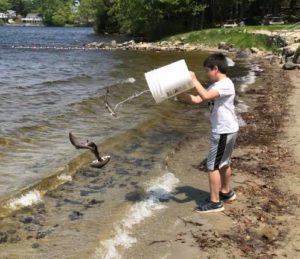
The youths stocked about 300 rainbow trout, all 14+ inches in length into Otis Reservoir from Camper’s Beach at the Tolland State Forest. Some of those fish were HUGE!! DFW staff would put a couple of trout into empty 5 gallon pails and the kids would run to the shore and tossed them into the water. According to DFW Aquatic Biologist Leanda Fontaine-Gagnon, stocking the fish in this manner is good for the trout as they require a little jolt to get them started.
Accompanying the students was Ms Graham, a teacher who also got into the act by also running a pail of fish to the water’s edge and sending them flying into the water.
Bass tournament
The Greylock Bass Club held a bass tournament on Onota Lake on May 13 and the results are as follows: 1st place went to Dave (DJ) Benham with a 5 fish catch weighing 17.8 lbs, 2nd Place went to Paul Procopio with 11 lbs 10 oz (5 smallmouth bass), 3rd Place went to Jim Underhill with 9 lbs 8 oz (4 largemouth bass) and tied for 4th place were Joe Chague and Rick Turczak with 7 lbs 12 oz.
According to spokesman Bill Gates, they had 10 anglers with a 30 bass total (average of 3 bass, each even though the limit is 5). After 4th place the weight averages were 1 lb per angler. With the exception of Dave’s 17 lbs, the weights were down an average of 7 lbs per angler. There were only 2 bass over 3 lbs and Dave caught both of them.
In his 40 plus years of fishing Onota lake, Bill believes that “It has never looked this environmentally terrible. There isn’t any weed growth at all and the water clarity is awful. There is a lack of sub-species, (perch, bluegill and the rock bass) of which Onota Lake is famous”. “Don’t forget”, he said, “we may not be professional bass anglers but we are very competent. Onota lake always took 18 lbs to win and for the past 25 years 90% of the participants had 5 fish limits with an average of 10 lbs or better. This is the best time of year to catch bass over 3 lbs because both largemouth and smallmouth are in the spawn or pre-spawn stage. Yet nobody found any bigger fish”.
“I know weeds are a blight to home owners and water skiers, and sculling teams hate them, but to see what is happening to the wildlife is disheartening. “I am not looking to get involved with the politics of lake management”, he said, “I’m sure somebody would come up with a well paid for study that can justify the events at Onota Lake. I, unfortunately, have to rely on my 60 years (of experience) to fall back on.”
Bill believes the above situation is caused by the annual lake drawdowns as well as the applications of herbicides.
Spring trout stocking ended
According to Western District DFW Supervisor Andrew Madden, no more spring trout stocking is anticipated this year. Many thanks go to Deb Cote, DFW Clerk, for providing us those weekly updated stocking lists. Providing those figures to us undoubtedly caused extra work for her because such information is also provided on their web site.
Please leave young wildlife alone
The following is a message from MassWildlife: The arrival of spring means the arrival of newborn and just-hatched wildlife. Every year, the lives of many young creatures are disturbed by people who take young wildlife from the wild in a well-intentioned attempt to “save” them. These well-meant acts of kindness tend to have the opposite effect. Please remember, finding a young animal alone does not mean it’s abandoned; the best thing you can do for young wildlife is to leave them alone.
Young wildlife removed from the wild are denied important natural learning experiences which help them survive on their own. Most people quickly find that they can’t care for young wildlife, and many animals soon die in the hands of well-meaning people. Young wildlife that survive human “assistance” miss experiences that teach them to fend for themselves. If these animals are released back into the wild, their chances of survival are reduced. Often, the care given to young wildlife results in some attachment to humans and the animals may return to places where people live, only to be attacked by domestic animals, or hit by cars. Some animals become nuisances and people have been injured by once-tamed wildlife.
Generally, young mammals are visited by their mother only a few times a day to avoid attracting predators to the young. For example, a nest of bunnies will only be visited by the adult female twice per day to nurse the young. The young are generally safe when left alone because their color patterns and lack of scent help them remain undetected. The same is true for fawns (young deer). Fawns are safest when left alone because their camouflaging color helps them remain undetected until the doe returns. If sympathetic people repeatedly visit a fawn, it can prolong the separation from the doe and delay needed feeding. Unlike deer, newborn moose calves remain in close proximity to their mothers who, in contrast to a white-tailed doe, will actively defend calves against danger. An adult cow moose weighing over 600 pounds will chase, kick or stomp potential predators, people included.
Only when young wildlife are found injured or with their dead mother may the young be assisted, but must then be delivered immediately to a licensed wildlife rehabilitator. Due to the difficulty in properly caring for them, there are no rehabilitators licensed to care for fawns. It is illegal to possess most wildlife in Massachusetts without a permit.
Column change – Please note
Please be advised that from now on, scheduled events (upcoming fishing derbies, youth hunts, gun courses, etc) will no longer be listed in this column. Such information should be sent to the Sports Editor, Geoff Smith at gsmith@berkshireeagle.com or his office number 413-496-6254. He will start running them during the week in the “Area Notes” section of the Sports Section whenever there are enough events to announce. I do plan to continue listing the results of the derbies, youth hunts, etc.
Ronald R. Smith, Turkey Hunting History Maker1980
Wild turkey hunting began in Massachusetts in 1980 and the following year, on the second day of the season, a little bit of Massachusetts turkey hunting history took place right here in the Berkshires. In the predawn darkness, Ron Smith, then of Lee, now of Pittsfield, MA, was carefully picking his way through thick brush and trees down a wooded mountainside to an area where he hoped to find a roosting tom turkey. He imitated the call of a barred owl (a turkey predator) and a tom responded with a loud gobble about 100 yards away.
After waiting until it was light enough to find a good spot to stand, Ron selected an area where there was a large tree behind him to break his outline and disguise his presence. He was also fully camouflaged, including his face, hands and bow. He was somewhat familiar with the area as he had done some pre-season scouting there. Cupping his hands to his mouth, he called again, this time clucking quietly to imitate the soft “tree call” of a roosting hen. The tom responded immediately, rapidly gobbling several times. Ron cautioned himself not to call too frequently, which could cause the tom to become suspicious and disappear.
He said that he was “unusually calm”, probably because he had accepted the probability that any chance for bagging a wild turkey with a bow and arrow was just about nil. The fact that he had practiced for months did little to restore his confidence. A wild turkey is capable of spotting a slight finger movement at 80 yards, and if they do, they are out of there.
Several hundred yards further off, another roosting male started gobbling resulting in fierce competition. Each bird tried to outdo the other in his attempt to lure the hen by calling continuously. Ron’s concern mounted because other hunters might hear the birds, arrive at the scene and unintentionally ruin any chances that he may have at taking a tom.
He could hear the flapping of wings as the nearest tom left the tree and landed behind some thick brush about 80 yards away. The tom double and tripled gobbled and paraded back and forth waiting impatiently for the hen to come to him. Ron turned his head, covered his mouth and issued a few muffled yelps with the hope that the tom would think the hen was losing interest and was wandering off.
The tom stopped calling and Ron knew he was coming in. He raised his 57 pound draw Wing Impact compound bow to a shooting position and nocked the arrow. Seconds later, there was movement some 40 yards to his right. The bird had partially circled him and was proceeding cautiously, with head turning and stretching and eyes searching for the hen. He was heading for a nearby clearing. Ron had specifically chosen that opening right in front of him knowing that turkeys seldom venture into bushy areas where vision is limited.
Now the excitement suddenly his Ron, his mouth became dry and his chest started pounding and his arms started to shake. It appeared as though the bird’s piercing eyes were staring directly into his. About 12 yards away, off to the right, the bird stopped behind a large tree. That gave Ron the opportunity to adjust his shooting position and draw his bow. After a while, his head appeared, his black eyes penetrated Ron’s eyes and then withdrew his head and disappeared. There was silence. Then came a strange hissing and drumming sound and the tom stepped out strutting in full display. Ron let the arrow fly and it was over.
Then he sat down to control his shaking. He was a history maker for he had taken a turkey with a bow, the first turkey bagged with a bow and arrow in Massachusetts modern times.
The bird weighed 17.7 lbs, had 1 ½ inch spurs and a 9 ½ inch beard.
The late Ted Giddings, Editor for the Berkshire Eagle, covered the story and had the attached picture of Ron and the tom on the front page of the May 6, Berkshire Eagle, with the headline. “Lee man sets modern first by killing turkey with bow”. Ron also wrote about his experience and his story was featured in the May 1983 issue of Bowhunter, the National Magazine for the Hunting Archer.
Ron has always been an avid sportsman. Over the years he has served as President of the Berkshire County League of Sportsmen and still is a delegate to the League. He was named Sportsman of the Year in 1995. He was secretary of the Lee Sportsmen’s Association for over 30 years and taught Bowhunting Eucation for the Commonwealth of Massachusetts for many years. He has served as President of the Taconic Chapter of Trout Unlimited. (In fact, he signed my diploma for passing a fly tying course back in 1982).
Now, at the age of 83, Ron is still an avid sportsman. He still bowhunts for deer and turkeys and goes out west to hunt elk in Montana, although lately, he hunts for elk with a camera. He is a member of several other sportsmen’s clubs, and, lest I forget, he is the elder statesman of the ROMEOs (Retired Old Men Eating Out), a group which gathers for lunch weekly.
Father, daughter have great spring turkey hunting season
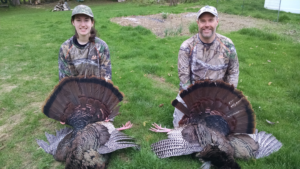 Say, remember my May 6, 2018 column wherein I mentioned the Youth Turkey Hunting results? In that article, I mentioned that Grace Krzanik of Adams, while being mentored by her dad Scott bagged an 18 lbs bird. Well guess what? On May 12 Grace and Scott went hunting again and she shot her second tom at 5:19 am. As they were heading back to the truck, she heard gobbles, so they went back to where she shot hers and set up again. Two more came in behind them and Scott shot his second bird of the season at 6:30am. Both father and daughter tagged out for turkey season.
Say, remember my May 6, 2018 column wherein I mentioned the Youth Turkey Hunting results? In that article, I mentioned that Grace Krzanik of Adams, while being mentored by her dad Scott bagged an 18 lbs bird. Well guess what? On May 12 Grace and Scott went hunting again and she shot her second tom at 5:19 am. As they were heading back to the truck, she heard gobbles, so they went back to where she shot hers and set up again. Two more came in behind them and Scott shot his second bird of the season at 6:30am. Both father and daughter tagged out for turkey season.
Incidentally, Spring Turkey Hunting Season ended yesterday.
Trout stockings
The following waters were scheduled to be stocked with trout last week: Clesson Brook and Upper Branch of Clesson Brook in Ashfield and Buckland, Greenwater Pond in Becket, Westfield River in Becket, Chester, Huntington, Montgomery, Middlefield, Russell, Savoy, Worthington, Cummington, Chesterfield and Windsor; Deerfield River in Buckland, Florida and Charlemont; Cold River in Savoy, Florida and Charlemont, Chickley River in Hawley and Charlemont, Littleville Reservoir in Chester and Huntington, North Pond in Florida, Pontoosuc Lake in Lanesborough, Laurel Lake in Lee, Housatonic River (C/R) in Lee and Stockbridge, Onota Lake in Pittsfield, Stockbridge Bowl in Stockbridge, Windsor Pond in Windsor, Lake Garfield in Monterey, Otis Reservoir in Otis, and Richmond Pond in Richmond.
Firearms Course
On Saturday, June 2, the Lee Sportsmen’s Association will hold a Multi-License Firearms Course from 9am until 4pm for a proprietary License-To-Carry course that qualifies for licenses in Massachusetts, Connecticut, Florida, New Hampshire, Maine, and Utah. (those not participating in the Utah class can expect to be completed at approximately 3pm) This comprehensive one-day course includes information for federal and state firearm laws, operation and safe handling of firearms, shooting fundamentals, care and cleaning, concealed carry methods, a live fire session on the pistol range, and much more.
Seating is limited to the first 25 students who register. Course fee is $150, or you can take only the MA & CT portion for $120 with live fire, or take only the Utah portion for $100 without live fire. State license application fees and processing are not included. Participants will receive a course certificate, application forms, an informative student resource CD, and supporting documents. All firearms, ammunition, and eye and ear protection will be provided, including lunch as well.
For more information, contact Robert McDermott at (413) 232-7700 or email robmcdermott@verizon.net.
Annual Harry A. Bateman Memorial Jimmy Fund Fishing Derby
The 26th Annual Harry A. Bateman Memorial Jimmy Fund Fishing Derby will take place on Saturday, June 2, at the Frank Controy Pavilion at Onota Lake in Pittsfield from 6:00 AM to 12:00 PM. No fishing license is required because it is Free Fishing Weekend for the state of Massachusetts.
The derby’s purpose is to raise money for the Jimmy Fund – Dana Farber Cancer Institute For Children. All of the proceeds will be donated to the Jimmy Fund in memory of Harry A. Bateman a former member of Central Berkshire Bowmen and I.U.E. Local 255 who was well known throughout Berkshire County and who became a victim of cancer in 1992.
Many trophies and prizes will be given out to the adult and youth winners of the fishing derby. There is even a special category for those fishing with a bow & arrow. All fish must be weighed in at 12:00 PM and can be caught at Onota Lake from boat or shore. Everyone still needs to register before all fish can be weighed in. You must be wearing your wrist band provided at the registration desk in order to receive food and to weigh in your fish.
Fishing tackle is given with the trophy prizes and 2 prizes for heaviest trout. A sportsman award, which includes a tackle box with over $100 of tackle, is given out to a child
Fee is $10 for adults and $5 for children 14 years old and younger and it includes food and beverages. No alcohol is served at this event. All children receive a free gift and they get a chance at winning a mountain bike. The carp shoot is part of the fishing derby because that was something that Harry enjoyed. Advanced tickets may be purchased at Avid Sports, Dave’s Sporting Goods, Maces Marine and Onota Boat Livery.
Stockbridge Sportsmen’s Club fishing derby
According to club spokesman Tim Minkler, some 64 fishermen and fisherwomen showed up for the SSC’s annual Fishing Derby on May 20 and fished from dawn to 3:00 pm at Stockbridge Bowl. Weather predictions were not good calling for rain most of the day with thunderstorms coming through mid-day and temperatures in the 60s. Well, the weather man was wrong. There were a few sprinkles throughout the day with a 10-minute cloud burst right around 2:30pm, but for the most part they stayed dry all day.
The $100 Winners were as follows: Largest Trout- Sheila L. Malumphy, Lee Ma., 1 lbs 12 oz., 16” long; Largest Bass- Tim Fogarty, Becket Ma., 3 lbs 8oz., 18” long, Largest Pickerel- Dawson Farina, West Stockbridge, Ma. 4 lbs, 2 oz., 26.5” long and Largest Bullhead – Seth Slemp, Lee Ma., 1 lb, 3oz, 12” long.
The Age 12 and Under Winner was Dylan Trumps of South Lee with a trout weighing 1 lb 2 oz and 13” long.
Fly-fishing with friendly spirits
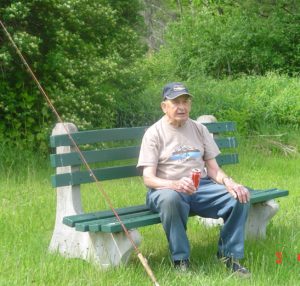

Every year, usually my first fly fishing outing, I bring along some friendly spirits. They accompany me in the form of fishing equipment that close fishing friends once owned and ultimately ended up in my hands. Usually, a next of kin wanted me to have it or the angler gave me the item before he passed beyond the riverbend. Over the years, I have fished with a rod that the late Joe Areno wanted me to have and one that the late Gordon Leeman once owned, or perhaps with the late Ralph Lichtenstein’s wading staff. Perhaps I wore a pair of waders that the late Tony Lorio‘s daughter, Catherine Gallant, passed on to me. While using the fishing equipment, I recall the fond memories that I had fishing with all these gentlemen who have since passed beyond the riverbend.
Yeah, I know it is goofy, but I actually feel their spirits and quite frankly enjoy their company. It allows me an opportunity to once again remember them and to reflect upon the good times that we had fishing.
Such was the case this year. Actually, it didn’t work out that my first day fishing this year was with them but with some live friends. So, this year, I took one along on my second trip….and this time my friendly spirit was that of the late Charlie Lahey. He passed away in 2010, at the age of 101, just days before his 102nd birthday. You may recall my writing about this gentleman and our fishing together when he was 101 years old….and he caught a couple of trout!
Last fall, his daughter Andrea Dimassimo surprised me with a wonderful birthday gift. Old Charlie’s flyrod, reel, vest, etc. She said that Charlie would want me to have them. He probably bought that flyrod in the 1950’s or 1960’s and back then, 50 years later, Charlie who was 100 years old at the time, would tell me that there was a lifetime warranty on that rod. How we would chuckle over that. Well, the least I could do was to take him fishing with me this spring.
So off we went, me with Charlie’s stuff, his Fenwick fiberglass flyrod, his Pflueger 1495 ½ fly reel, line, etc. I even took along some flies that Charlie had created when he used to fish the Mad River in VT. He named it the Mad River Special, a bucktail fly with an orange body, yellow throat, brown deer hair wing, woodduck tail and junglecock wing. On the rare occasion when he was having no luck with that fly, he would try his tandem fly (two hooks) with a fly on the front hook and a bare hook in the rear. He used to put some garden hackle on the rear hook. He named it his Add-a-Worm fly.
Charlie was a well-known angler from the Berkshires and VT and several articles were written about him in this column as well as The Berkshire Eagle. He was so famous that he ended up in the Freshwater Fishing Hall of Fame in Hayward, Wisconsin. Gerry Gibbs, famous writer for Outdoor Life Magazine and a Vice President from Trout Unlimited National, came to the Berkshires to present the award. Charlie’s induction was not just a listing in some log of honor or anything like that. No, his picture is on a plaque hanging on the wall along with notables such as Lee Wulff, Kurt Gowdy, even Isaac Walton.
You can well imagine the thrill of my fishing with this friendly spirit and using his rod and reel. We started off in the morning fishing the East Branch of the Housatonic River in Hinsdale, MA. I fished with his Mad River Special fly, with the predictable results – zilch, nada, no fish would even look at it. It brought me back to the many times when Charlie would be fishing between me and another deceased friend, Dave Oclair, and he would haul 2 or 3 nice trout right out from t under our noses and promptly release them unharmed. Dave and I were fishing the same pattern fly in the same type of water not 20 feet away, using the same action and we would catch nothing. Old Charlie really got a kick out of that.
There was a bench along the waters where we fly fished and periodically we would sit there and have a bite to eat and enjoy the day, usually a sunny comfortable one. Occasionally, we would have a swig of bourbon from my flask. That was Charlie’s preferred booze. Hey! He was 100 years old and it didn’t harm him yet. Then we would fish some more. What a privilege and honor to spend that time fly fishing with him.
I had to chuckle at the continuing lack of success with his fly on this day. It was only fitting, for that fly was created by and only responded to Charlie. I’ll bet he was looking down and chuckling while advising me to fish it slower, fish it lower, twitch it a couple of times, etc. I wanted so much to catch a trout on Charlie’s old flyrod and fly, but I finally had to switch flies.
This time I tried the Brown Charm, a fly that was developed by another renowned local fly fisherman in the 1960’s, the late Bill White. There were few accomplished local fly fishermen in the 1960’s-1980’s who hadn’t fished and had success using the Brown Charm. The late outdoor columnist, Ted Giddings, in one of his columns, called it his favorite fly. It was a wet fly with a pheasant tail, buff body ribbed with brown thread, wood duck wing and brown hen hackle. Thanks to another local fly fisherman, the late Homer Ouellette, who gave me the original pattern of that fly several years ago, I was able to tie it up.
Using Charlie’s old rod and reel and Bill’s fly, I cast it out into a likely looking run of the river and wham! There it was, the trout which made my hopes come true. The brown trout was lightly hooked in its lip in such a way that it was not necessary for me to touch it or remove it from the water. With the use of a hemostat, I simply clamped onto the barbless hook and with a gentle jerk unhooked it. The fish was in excellent shape as it swam away into the darkness of the stream. That fly produced other fish that day, too.
How cool wass that, catching trout on an old rod that was once owned by someone who is now listed in the Freshwater Fishing Hall of Fame.
An old philosopher once said, “It is the responsibility of those who live to carry on the hopes and dreams and spirits of loved ones and friends who leave us behind”. I guess that is what I was doing. What a nice feeling resting on a streamside log amidst the fiddleheads and trillium watching and listening to the babbling river while enjoying the pleasant spring day and fond memories of old Charlie.
“Here’s to you, old fella, we had another wonderful day.” I muttered to myself. “As always, I enjoyed your company”. Then, with scratchy eyes, I raised the flask and took a healthy swig of bourbon.
Incidentally, I learned about that above-referenced old philosopher, Richard “Dick” Gotshalk, while reading a recently published book entitled, “Holy Water, Flyfishing Reveries and Remembrances” by Jerry Kustich. It was advice given to the author by the philosopher shortly before passing beyond the river bend. Holy Water is a book written by a man who has spent his entire life as a fly fisherman, fishing rod maker, outdoor lover and conservationist.
I really related to this book as it appeared to be written by a fly fisherman approximately my age who recounted certain events in his life which occurred over the years….memories of his first fish caught, the places he worked, the places where he lived, people who influenced him during the years, the heartbreak of losing a loved one, working for Sweetgrass Rod Company, the river access issues that existed in Montana and other western states, Atlantic Salmon fishing, the increased interest in salt water fishing in the Caribbean, etc. Those events served as wonderful reminders of some of what our generation went through as well as provided a history lesson to generations which follow.
Prior to now, I had never read any of Kustich’s books. He wrote several, including, Flyfishing for Great Lakes Steelhead, At the River’s Edge, A Wisp in the Wind and Around the Next Bend. I intend to do so now after reading this book.
Through his angling essays, he has a writing style that tugs at the heartstrings of the fly fisherman that few authors have. Similar to what the late author Norman MacClean did with his epic novel, “A River Runs Through It”. I was wrapped in this book from the Introduction to the final words on the last page. Incidentally, on that last page writing about himself and his late wife Debra, he wrote:
“Time evaporates like water falling on hot pavement, so it is important to choose activities that are good for the soul while it is still possible. I often look back to that September on the Madison (River in Montana) in 1981 when Debra and I vowed to travel while we were still young enough to do so. As if that experience were a portent of things to come, we committed to a path of uniqueness like there was no tomorrow. It was a sacred journey. I could not have imagined back then that the Madison, beautiful in itself, would have inspired the subsequent decades of adventures to so many other inspirational waters that now seem to me holy. But that is the nature of rivers. One leads to another, and then another. They flow on forever, and forever connected, they enrich our souls and touch our spirits with mysteries that none of us can fully comprehend. Perhaps that is why we keep on going back.”
See what I mean about writing style?
The 187- page hard cover book costs $24.95, is published by West River Media and is available just in time for Father’s Day.
Trout Stockings
The following waters were scheduled to be stocked with trout last week: Green River in Alford, Egremont and Great Barrington; Ashfield Pond in Ashfield, Walker Brook in Becket and Chester, Westfield River in Chesterfield, Sackett Brook in Dalton and Pittsfield, North Pond in Florida, Housatonic River in Dalton, Hinsdale and Pittsfield, Upper Highland Lake in Goshen, Hubbard River in Granville, Williams River in West Stockbridge and Great Barrington, Norwich Pond in Huntington, Pontoosuc Lake in Lanesborough, Lake Buel in Monterey, Konkapot River in Monterey, New Marlborough, and Sheffield, Lake Garfield in Monterey, York Lake in New Marlborough, Windsor Lake in North Adams, Otis Reservoir and Big Pond in Otis, Green River and Hemlock Brook in Williamstown and Windsor Pond in Windsor.
